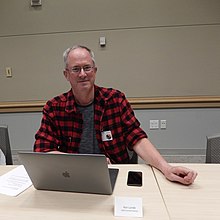|
Ideographic Research GroupThe Ideographic Research Group (IRG), formerly called the Ideographic Rapporteur Group, is a subgroup of Working Group 2 (WG2) of ISO/IEC JTC1 Subcommittee 2 (SC2), which is the committee responsible for developing the Universal Coded Character Set (ISO/IEC 10646). IRG is tasked with preparing and reviewing sets of CJK unified ideographs for eventual inclusion in both ISO/IEC 10646 and The Unicode Standard.[1][2] The IRG is composed of representatives from national standards bodies from China, Japan, South Korea, Vietnam, and other regions that have historically used Chinese characters, as well as experts from liaison organizations such as the SAT Daizōkyō Text Database Committee (SAT), Taipei Computer Association (TCA), and the Unicode Technical Committee (UTC). The group holds two meetings every year lasting 4-5 days each, subsequently reporting its activities to its parent ISO/IEC JTC 1/SC 2 (SC2/WG2) committee. History The precursor to the IRG was the CJK Joint Research Group (CJK-JRG), established in 1990. In May 1993, this group was re-established as the Ideographic Rapporteur Group (IRG) as a subgroup of WG2.[3][4] In June 2019, the subgroup acquired its current name.[2] The first IRG rapporteur was Kato Shigenobu (加藤重信), from 1993 to 1994, followed by Kido Akio (木戸彰夫) from 1994 to 1995.[4] From 1995 to 2004, the IRG rapporteur was Zhang Zhoucai (张轴材), who had been convenor and chief editor of CJK-JRG from 1990 to 1993. From 2004 to 2018 the IRG rapporteur was Hong Kong Polytechnic University professor Lu Qin (陸勤),[1][5] but in June 2018 the title of "rapporteur" was changed to "convenor", and Lu Qin continued as IRG convenor for another six years.[6] Since June 2024, the IRG convenor has been Ken Lunde.[7] OverviewIRG is responsible for reviewing proposals to add new CJK unified ideographs to the Universal Multiple-Octet Coded Character Set (ISO/IEC 10646), and equivalently the Unicode Standard, and submitting consolidated proposals for sets of unified ideographs to WG2, which are then processed for encoding in the respective standards by SC2 and the Unicode Technical Committee.[8][9] National and liaison bodies that have been represented in IRG include China, Hong Kong, Macau, Japan (no longer active), North Korea (no longer active), South Korea, Singapore (no longer active), the Taipei Computer Association (TCA), the United Kingdom, Vietnam, and the Unicode Technical Committee (UTC). As of Unicode version 16.0, the IRG has been responsible for submitting the following blocks of CJK unified and compatibility ideographs for encoding:[10]
Since 2015, proposed characters submitted by IRG member bodies have been processed in batches called "IRG Working Sets". Each working set undergoes several years of review by IRG experts before official submission of the working set to WG2 as a new block. Once accepted by WG2, the proposed block is processed according to the individual procedures followed by ISO/IEC JTC1 SC2 and the Unicode Technical Committee (UTC). In the case of SC2, this involves balloting of ISO member bodies.[11] The following working sets have been processed by IRG: WS2015. 5,547 submitted characters which resulted in 4,939 characters encoded in CJK Unified Ideographs Extension G (Unicode version 13.0, March 2020):
WS2017. 5,027 submitted characters which resulted in 4,192 characters encoded in CJK Unified Ideographs Extension H (Unicode version 15.0, September 2022):
WS2021. 4,951 submitted characters which may result in up to 4,302 characters to be encoded in CJK Unified Ideographs Extension J in a future version of Unicode:[14]
WS2024. A total of 4,674 characters were submitted for Working Set 2024 in July 2024 by China, Republic of Korea, SAT, TCA, United Kingdom, UTC, and Vietnam:[4]
References
External links
IRG Working SetsIRG Working Document Series (IWDS) |